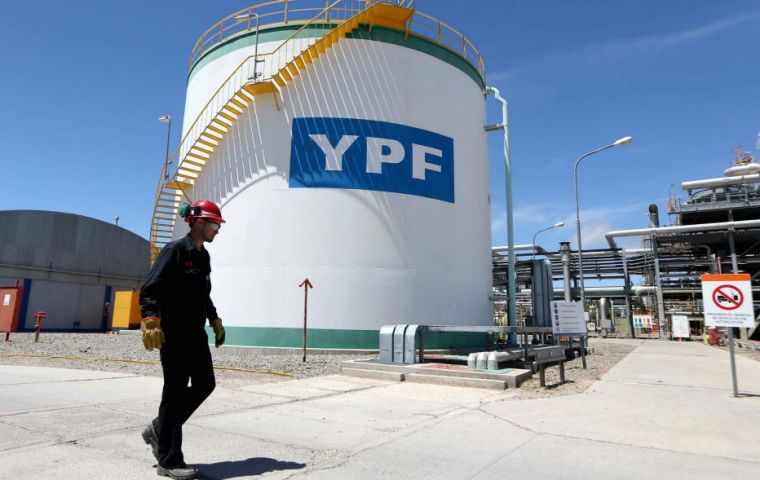MercoPress. South Atlantic News Agency
Is Argentina’s Shale Too Expensive To Drill?
 State-controlled YPF, Argentina's top producer, has said it has 71 shale oil wells and 10 shale gas wells in Neuquen that have been drilled but not completed.
State-controlled YPF, Argentina's top producer, has said it has 71 shale oil wells and 10 shale gas wells in Neuquen that have been drilled but not completed. By Irina Slav, Oilprice.com – It is one of the most abundant shale plays in the world, with oil reserves of up to 16 billion barrels and gas reserves of 308 trillion cubic meters—resources that could guarantee a country’s energy independence and turn it into a relevant international supplier of oil and gas. But only if the price is right.
Vaca Muerta was Argentina’s hope for energy independence and even international success as an exporter of oil and gas. But that was before the oil price crash and before yet another financial crisis in the country that slowed energy investments. Nevertheless, State-controlled YPF, Argentina's top producer, has said it has 71 shale oil wells and 10 shale gas wells in Neuquen that have been drilled but not completed.
In mid-2019, companies had said they would invest a total of more than US$ 6bn in upstream projects in Neuquen in 2020. Now the number is closer to US$ 3bn, the lowest since 2016, according to provincial data.
Companies put the brakes on investment following a fuel and crude price freeze implemented in August 2019 by the administration of then-president Mauricio Macri shortly before he lost reelection to Alberto Fernandez.
The price freeze, coupled with policy uncertainty under the new government and weaker market conditions this year, eroded Argentina's climate for upstream investment.
Shale-rich Neuquen nonetheless saw an increase in oil production in July. Crude output rose by 10%, on the year, to 155,400 b/d, according to the provincial government. Of that total, 77%, or 119,500 b/d, was unconventional and 60,419 b/d was exported.
positive sign for the long-term—if not the short-term—future of the shale play. Another supermajor who is betting on the long-term attractiveness of the Vaca Muerta is Shell. The Anglo-Dutch super major said recently that it would delay some projects in the play but would not be going away.
“In the long term, Vaca Muerta has the ability to be competitive [internationally],” Shell Argentina president, Sean Rooney, told media earlier this month. “I am confident that we are seeing a delay of one to two years until we can resume new investments.
Vaca Muerta’s development, even before the latest colossal oil industry crash, was marred in various challenges. For one thing, production costs were too high because of the lack of infrastructure in place and the fact that things like frac sand and water had to be transported over long distances to reach the wells. For another, pro-business president Mauricio Macri’s reformist government lost the last election with another financial crisis rattling Argentina, dampening appetites for expansion in the Vaca Muerta, especially after the new government featured ex-president Christina Fernandez as vice-president, Oilprice.com’s Latin America correspondent Matthew Smith wrote recently.
Fernandez led the nationalization of YPF in 2012 and now sparked worry among energy companies that the new government could again embark on an interventionist agenda despite assurances from the vice-president that this would not be the case, Smith noted.
Despite all these problems, all is not lost. Production costs have been falling in the Vaca Muerta, so the improvement in oil prices we have seen since this spring’s lows would motivate some drilling. According to a Wood Mackenzie analyst, as long as Brent is above US$ 30 a barrel, the most developed parts of the Vaca Muerta would again start making economic sense, Bloomberg reported in April. Brent is not trading above US$ 40 a barrel, and while this may be too low for Middle Eastern producers, it is high enough for some Vaca Muerta projects.
In addition to the favorable price development, President Alberto Fernandez has pledged to the energy industry to support it with new legislation safeguarding investments already made in the shale play. Some argue that these safeguards will not be enough to spur on more drilling, compromising not just Argentina’s entry into the international oil market but its energy independence, especially in gas. Othersbelieve, based on super majors’ continued presence in the play, the Dead Cow could become the next Permian, only with even lower production costs.
Government estimates from a couple of years ago saw the Vaca Muerta boost national oil production to some 1 million bpd and gas production to 260 million bpd by 2023. State energy major YPF had to plans to expand its LNG export capacity, although it had to drop these this year as the LNG glut weighed on prices. Shell has also had to revise its plans for boosting Vaca Muerta production to 40,000 barrels of oil equivalent daily by 2021. Others have delayed growth plans as well. But none has exited the play yet.
There are currently eight drilling crews in the Vaca Muerta, according to Argentine media. That is down from 36 in November last year. Of course, hardly anyone would have expected that the shale play would remain untouched by the latest storms in global oil and gas. And yet, Shell and Equinor partnered in January to buy a new block in the Vaca Muerta from Schlumberger. True, in January, no one had any idea about what was coming in March and April, but in Argentina, things were already difficult for oil and gas companies.
That acquisition and now Exxon’s new license to drill suggest that despite the multiple challenges, the Dead Cow still has rich enough potential to compensate for those.




Top Comments
Disclaimer & comment rulesCommenting for this story is now closed.
If you have a Facebook account, become a fan and comment on our Facebook Page!